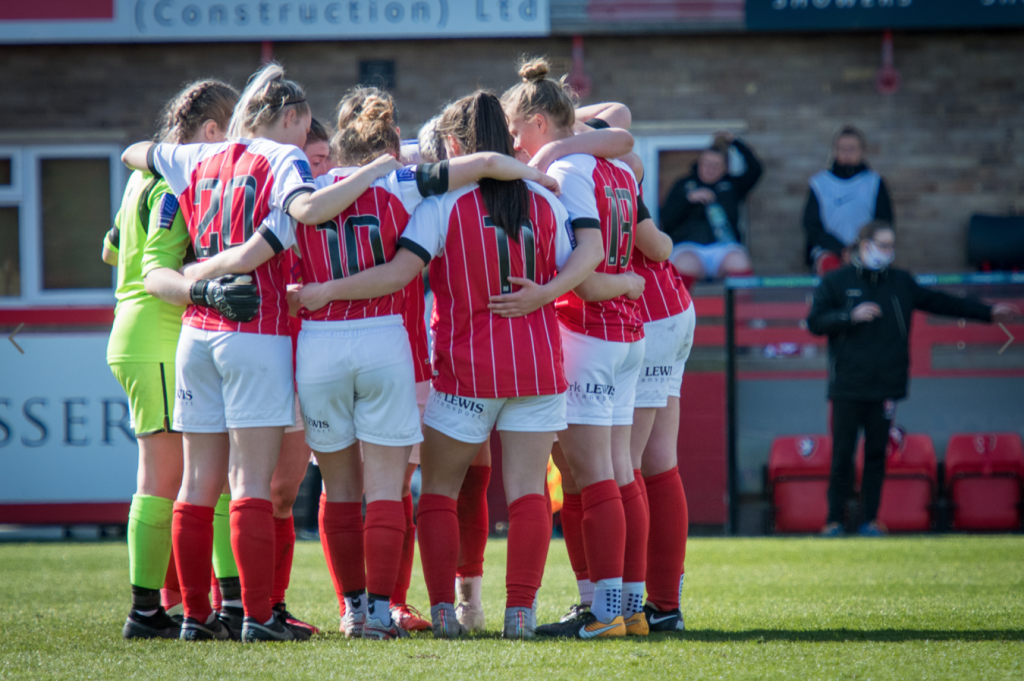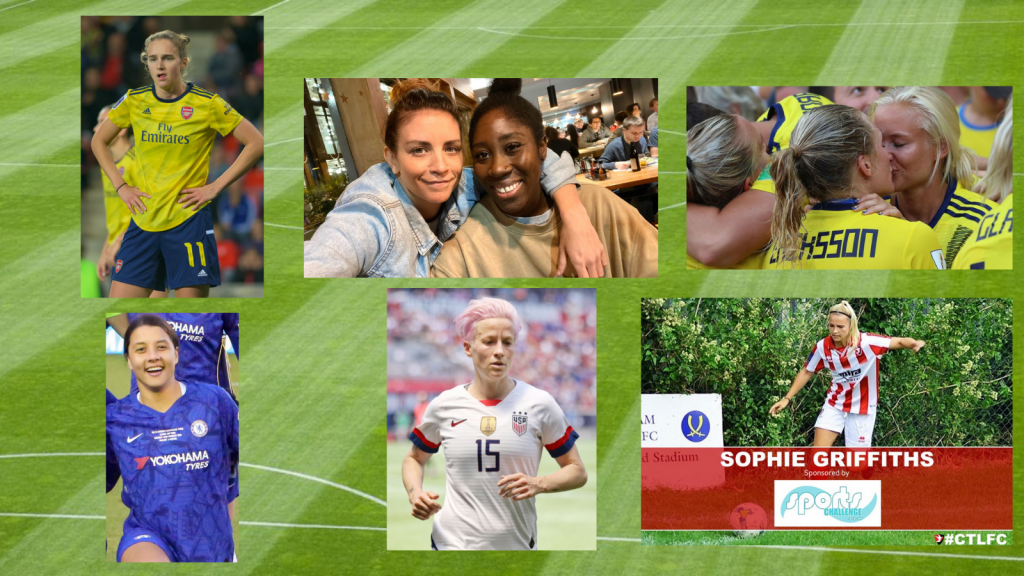Pride Month: Why is women’s football so much more LGBTQ+ inclusive than the men’s game?
In the third and final feature of his series on football for Pride Month, Danyal Khan asks Cheltenham’s Sophie Griffiths and sports reporter Beth Fisher whether they think the men’s game really is following the example set by the women’s game on LGBTQ+ inclusion…
Throughout this feature, you will also hear from football fans who are LGBTQ+ as they offer their views on why women’s football is more inclusive than men’s…

Women’s football leading the way for LGBTQ+ inclusivity at the highest level – and what the men’s game can learn

Megan Rapinoe, Vivianne Miedema and Sam Kerr are three of many LGBTQ+ players who play at the highest level in the women’s game.
Each of them are stars that shine bright for club and country every year, and as a result they inspire younger generations of LGBTQ+ girls into pursuing their dreams of becoming professional footballers.
The first name of the three – and arguably the biggest advocate for LGBTQ+ rights within the game and within society – Rapinoe is seen as a role model to Cheltenham Town Ladies academy graduate Sophie Griffiths.
Griffiths, 25, has made her breakthrough into the Robinesses side this season as an openly LGBTQ+ player.
- Pride Month: To what extent is football becoming more inclusive for the LGBTQ+ community?
- Pride Month: How are LGBTQ+ fans groups helping to change football?
- Pride Month: The rise of LGBTQ+-inclusive football clubs in the UK
Rapinoe’s influence in trying to inspire change for the LGBTQ+ community is admired by the young forward.
“There are quite a few I look up to, who set the bar high for women’s football,” Griffiths says. “Megan Rapinoe is a really good role model for me.
“She says it as it is, doesn’t care about how people see her and she’s very much to the point.
“Her morals, and the way she goes about things, are really good. And she has the best interests of everybody.
“Looking at the stats, around 40 women at the most recent World Cup were out, so that goes to shows the impact people like Rapinoe are having on the women’s football landscape. They are always changing things for the better.”
Rapinoe’s work has created the environment for players to be open about their sexuality, and Griffiths feels accepted by the rest of her team at Cheltenham.
“I feel really accepted at the club and it’s absolutely fine,” Griffiths reveals. “All the girls there are amazing. You find that a lot of the team are LGBTQ+ or are friends with someone who is. It’s completely normal and nobody ever says anything.
“I find it easy, which shows how accepting we are as a club and more specifically women’s football is to LGBTQ+ people like myself.”
Griffiths, who works as a teacher, explains why she thinks the women’s game is more LGBTQ+ inclusive than the men’s.
“For as long as I can remember, it’s always been quite accepted in the women’s game,” Griffiths reflects. “Maybe it could be something to do with the fact that it’s a newer institution, that has definitely helped with acceptance.
“But many girls grow up in these teams, we are surrounded by LGBTQ+ people all the time, meaning it’s easier for them to accept that there are some different players in the team.
“I don’t believe that because you are going to be in this team, you are going to fall into this LGBTQ+ culture and therefore become LGBTQ+ yourself.
“I feel like a lot of people who don’t follow women’s football perceive the situation like that.
“In the men’s game, it’s all about stigma and fear of change.”
The theme of acceptance and being open with your identity is normalised in the women’s game, but what is the situation like in the men’s?
Taking the daunting step into the unknown hasn’t been a path followed by many regarding coming out in English men’s football.
In fact, the late and great Justin Fashanu was the only footballer to come out whilst being a player in the top four leagues of English football, and this happened in the 90s.
A new millennium later, and still we wait for a player to replicate the bravery Fashanu demonstrated all those years ago.
Instead, retirement and coming out in another country have been the paths that the brave Thomas Hitzlsperger, Robbie Rogers, Andy Brennan and Collin Martin have all taken when balancing out their sporting and personal lives.
Why is there such a big cultural stigma within the footballing remit in this country?
LGBTQ+ sports reporter Beth Fisher explains: “I think there’s loads of complex issues, but you know what I always say is forget about the sport for one minute, these men have got to come out to their families and friends and to themselves.
“And for a sportsman, coming out can affect certain things such as sponsorship opportunities and transfer possibilities.
“But coming out and accepting that you’re gay, is hard for some footballers who are from parts of the world where being homosexual is still considered to be illegal.
“There are so many layers to people coming out and then obviously coming out publicly is another layer which none of us really ever have had to go through.”
The question remains, will we ever see a couple of LGBTQ+ role models playing at the top level in the men’s game?
Griffiths is optimistic about the new younger generation helping when it comes to future players equalling the progress made in women’s football.
Griffiths predicts: “In years to come, this will definitely be something that I can see happening.
“It’s just one of those things that will take time. We need people in the men’s game to follow the example of the women and say, ‘it doesn’t really matter who you are’.
“I’ve got so many male friends who are heavily into football, and they have gay mates, and they are absolutely fine with them and have no problem with them at all.
“They are normally there as support, and I feel like this is starting to become more of a thing within younger generations, which is positive to see.”
Undoubtedly, there is a long way to go until this is a possibility in the men’s game. But the women’s side of the sport has given a blueprint as to what needs to be replicated.
The rise of LGBTQ+ all-inclusive clubs and fan groups is a good start, but more needs to be done to bring about parity between the two.
Rapinoe, Miedema, and Kerr have shown it’s possible to be a top-level LGBTQ+ footballer, and it’s now time for the men’s game to move into a more tolerant era of acceptance and inclusion.
Thanks to Danyal and all those he interviewed for his ‘LGBTQ+ In Football’ series.
Sports Media LGBT+ is a network, advocacy, and consultancy group that is helping to build a community of LGBT+ people and allies in sport. We’re also a digital publisher. Learn more about us here.
LGBT+ in sports? Your visibility will inspire other people – sharing your story can be hugely rewarding and you don’t have to be famous to make a positive and lasting impact. We encourage you to start a conversation with us, in confidence, and we’ll provide the best advice on navigating the media as part of your journey so that you retain control of your own narrative.
Email jon@sportsmedialgbt.com or send a message anonymously on our Curious Cat.



3 Comments
Pride Month: To what extent is football becoming more inclusive for the LGBTQ+ community? - Sports Media LGBT+ · 21/06/2021 at 1:36 pm
[…] 3) Pride Month: Why is women’s football so much more LGBTQ+ inclusive than the men’s game? […]
Pride Month: How are LGBTQ+ fans groups helping to change football? - Sports Media LGBT+ · 21/06/2021 at 1:38 pm
[…] Pride Month: Why is women’s football so much more LGBTQ+ inclusive than the men’s game? […]
Pride Month: The rise of LGBTQ+-inclusive football clubs in the UK - Sports Media LGBT+ · 21/06/2021 at 1:40 pm
[…] Pride Month: Why is women’s football so much more LGBTQ+ inclusive than the men’s game? […]
Comments are closed.